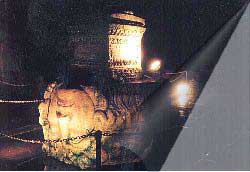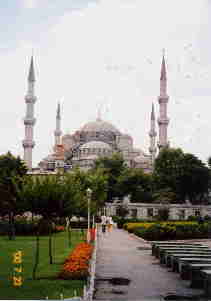Istanbul , TURKEY


Since, in the Louvre, Ingres's naked beauties who " have extra vertebrae", had awaked my interest in Istanbul; I had dreamed of my visit to there. Yet, what had kept it away from me, it was not until thirty years later that the dream came true. On the edge of the hill which is so beautiful as to lie surrounded by the sea on three sides and amongst the inimitable scenery produced by the harmony between nature and the history; stands the palace called the 'Topkapi Sarayi' , that is to say, the 'saray' having the 'kapi' equipped with the 'top' which commands the Bosporus Strait which has been one of the important points of contact between the East and the West especially in commerce. In this Seraglio, precious things of various sultans, which have been kept intact, because not looted, since the Ottoman Empire, are housed as collections; for example, the collection of a huge mass of treasure which contains the 16-carat diamond made out of the gemstone for which several spoons are said to have been needed in bartering at a bazaar, stuns all on seeing it. It was a collection of ceramics of tableware that attracted my interest; the collection consists of Chinese celadon porcelain, blue-and-white porcelain, dishes of painted china made at Ching-te-chen, Arita ware in a Kakiemon style, and otherwise; they are considered used for poison tasting or habitually by successive sultans. Through the Roman double-deck aqueduct, water have poured into the huge reservoir where the water is said to have been stored for the inhabitants of the Saray; the reservoir still survives and is commonly known as "Underground Palace", supported by some dozens of the Corinthian order. The inside of the reservoir was cool, against the outside; I saw some water trickling down in drops from the ceilling and the head of Medusa lying secretly in the depth of the darkness of the water and glaring fiercely as if watching for all who had looked upon it to turn into stone. I crossed from Sirkeci to Uskudar by sea. On return, because pedestrians were prohibited on the Bosphorus Bridge,I took a taxi to Taksim. Then a walk along Istiklal Street brought me to the Galata Bridge. I walked across this drawbridge on the day I arrived at Istanbul. From the next day, to my surprise, the bridge has been raised for the traffic control against student movement. On a rainy morning I left for home. While waiting for a bus to the airport I spared time to visit nearby Galata Kulesi which was originally built around the beginning of the sixth century. Inside this tower I paid for the elevator and went to the upper floor, where I found a restaurant and a nightclub like those in luxury hotels. When I heard that here one can drink, relax and watch belly dance while enjoying a night view, I felt strange since this is an Islamic country. Then I went up spiral stairway to a terrace corridor and I could have panoramic views of the Bosphorus Bridge and Istanbul spread over two continents. Basically the appearance of the city has not changed for five hundred years since the time of the Ottoman Empire. Chaotic streets and houses in the old city did not fit the image of modern metropolis. On my way back, narrow and winding back streets sloped. Paving stones, looked several hundred years old, were turned up and scattered leaving sloppy paths. It is a pity that I could not come across adorable odalisque after all in this eternal city. ( 1992/10/27 )

